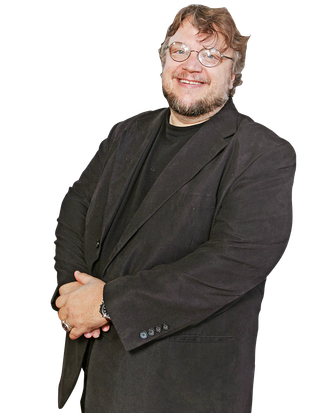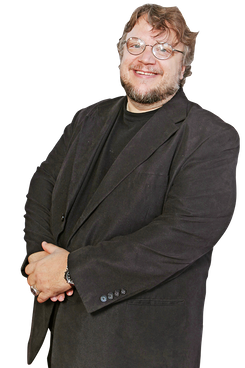

Since his 2006 breakthrough Pan’s Labyrinth, Guillermo del Toro hasn’t had the best luck mounting a film: He had to pull out of The Hobbit after dedicating months to the project, and his James Cameron–produced H.P. Lovecraft story At the Mountains of Madness fell apart just before he was about to start shooting — and with Tom Cruise attached to it. But before you feel too bad for the writer-producer-director, take a look at his IMDb profile: This week, Don’t Be Afraid of the Dark, the Katie Holmes horror flick he produced and co-adapted (it was originally a 1973 made-for-TV movie), hits theaters. Plus, he’s directing a sea-monster movie, Pacific Rim, and producing his own adaptation of Pinnochio. And that’s just scratching the surface. We got del Toro to give us a rundown.
Do you feel as overwhelmed by producing a film as you do directing one?
Yeah, to me it is a big commitment to present a movie. I did it with The Orphanage — I try to do it with movies that I feel very, very close to, you know? Don’t Be Afraid of the Dark is a movie that I’ve been trying to get made in one way or another for over thirteen years.
J.A. Bayona [director of The Orphanage] is working on a disaster movie called The Impossible. Have you stayed in touch with him?
Yeah, yeah, yeah. I read that screenplay. He invited me to produce it with him, but I really didn’t … I don’t relate to movies outside of the genre that much. I produce every kind of movie in Mexico and Latin America, but I didn’t feel I was that close to it. But we’re still in touch. In fact, he contacted me last week, asking me to take a look at his director’s cut for the movie. He’s coming to Toronto to show me the cut of the movie and I’ll give him any suggestions that I may or may not have. I think that Juan Antonio is the real deal. I have the utmost faith in him.
I’m sure you’re sick of hearing this, but as a fellow H.P. Lovecraft nerd, I have to express my disappointment that your adaptation of his story At the Mountains of Madness was scrapped.
That was a very painful experience. The cancellation came at a point where we were ready to start production. We story-boarded the key sequences in the movie, we designed all the creatures, we started doing tests on the creatures. We had every indication that the movie was going to roll. And it was the fact that I wouldn’t do it without a contractual R rating that took it down. I think, ultimately, I could have said yes to a PG-13, but I didn’t want to. I didn’t want to on paper. I believe the movie would have been a graphically violent movie and we may have been ended with a PG-13. I didn’t want to compromise from the get-go, you know?
Would you say that your experience with your 1997 film Mimic, which you’ve said you were unhappy with, taught you the importance of walking away from a project when there are creative differences?
Yes. It taught me a very important thing, which I didn’t know before, and it’s the word no. I think I was able to say no very strongly and very purposefully to many of the worst attempts at conforming Mimic, but I lost a lot of battles in that movie and I don’t blame anybody but myself for that. Now we have restored the movie on Blu-ray and DVD to a form closer to what I thought it should be. It’s not exactly the movie I wanted to make, but it’s closer.
Where are you with Pacific Rim?
We are in the height of preproduction, scouting locations, finishing the design of the monsters, storyboarding; we are literally two and a half months away from shooting. It’s happening. That’s the movie that, as a director, it occupies my mind entirely. I have no other projects as a director at this time.
How hands-on are you with your special-effects team and your artistic and set designers?
I would say incredibly hands-on, unfortunately [laughs]. I try to get involved with anything visually or aurally that comes into the screen — any sound, audio track, color, shape, any texture. So, essentially, if you visited my offices, [you’ll see] they are right in the middle of the concept department. I am right in the middle of the designers because I make the rounds. Or I make them come into my office every hour, every day, around the clock.
What about the third film in your Spanish Civil War trilogy? Is that Dos Espada?
Oh no, that is definitely not happening anytime soon. In the immediate future, I have things like Frankenstein, Beauty and the Beast, Haunted Mansion, and Pinocchio. For that we have half of the money in place, we have the screenplay, the storyboards, the puppets, the concept art. We’re ready to go into production as soon as we finish financing. And I have The Hulk at ABC. A TV series. I’m writing it with David Eick, who is one of the creators of Battlestar Galactica. We’ve been working on it for about a year or so.
How’s the tone of the Beauty and the Beast project coming?
Well, I met with Emma Watson about it because I’m very interested in doing the movie with her. She’s just perfect for the film, and we talked about the classic iteration of the tale. I love the sort of darker, beautiful, hopelessly romantic but Gothic take on the tale. We discussed this.
You didn’t mention the InSANE video game that you’re working on. Is that the one that you said you wanted to be “The Citizen Kane of video games?”
No, no, no, no, no. Make no mistake, I always say that in the future, somebody will make the Citizen Kane of video games. I would never claim that mantle for my own work in any field. I hope somebody does that. No, InSANE is a game that I’m very happy to be developing. It’s a learning experience. I would never think it’s going to be the Citizen Kane of video games. But I think it’s going to be damn fun, action-packed, and scary.

